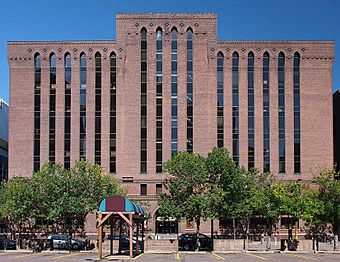Butler Square facts for kids
Quick facts for kids |
|
|
Butler Brothers Company
|
|

The Butler Brothers Company building from the southeast
|
|
| Location | 518 First Avenue North 100 North Sixth Street (corner of First Avenue and Sixth Street) Minneapolis, Minnesota |
|---|---|
| Area | 1.288 acres (0.521 ha) |
| Built | 1906–08 |
| Architect | Harry Wild Jones |
| NRHP reference No. | 71000437 |
| Added to NRHP | March 11, 1971 |
Butler Square is a famous building in Minneapolis, Minnesota. It was once a huge warehouse. Today, it holds offices and shops. This building is located in the city's old warehouse district. It was added to the National Register of Historic Places in 1971. This means it is a special historical place.
The building shows a simple but strong design style. This style is called the Chicago School. A famous architect named Harry Wild Jones designed it. He also designed other important buildings in Minneapolis. These include the Minneapolis Scottish Rite Temple and the Lakewood Cemetery Chapel.
Contents
What Was Butler Square?
Butler Square was first built for the Butler Brothers Company. This company sold goods by mail order. Think of it like an old-fashioned online store! The building sits on land that used to be a baseball stadium. It was called Athletic Park.
How Was This Huge Building Constructed?
The building needed to be very strong. It had to hold many heavy goods. So, it was built with thick masonry walls. These walls had small, deep-set windows. The top edges of the walls had decorative brickwork. This is called a corbelled parapet.
Inside, the building used heavy timber. Large posts and beams were made from Douglas fir trees. These trees grew near Aitkin, Minnesota. The wooden columns were very wide at the bottom. They measured about 61 centimeters (24 inches). They got narrower on the upper floors.
Special Features of the Original Warehouse
The basement of Butler Square had a horse stable. This was for the horses that pulled delivery wagons. The building also had three large boilers. These boilers burned coal to provide heat. Mechanical elevators helped move goods between floors. A special rail line connected to the building. This allowed boxcars to load and unload goods easily.
Over time, trucks became more popular than trains. This made the building's location less useful for a warehouse. It was no longer the best way to move goods.
Butler Square's New Life
In 1972, a real estate developer bought the building. His name was Charles Coyer. He planned to turn the east side into offices and shops. This was a big change for the old warehouse.
Bringing Light Inside
The original building had large floors and small windows. This meant not much natural light reached the inside. To fix this, a central open space was built. This space is called an atrium. It let natural light flood into the building. This made the office and retail spaces much nicer.
More Renovations and Impact
Later, in 1979, James H. Binger bought the building. He had similar plans for the west side. Another atrium was added there. This new atrium showed off more of the heavy timber structure. Better heating and cooling systems were also installed.
The renovation of Butler Square was very important. It helped start new development in the Minneapolis Warehouse District. It also encouraged people to save other old buildings in the area.



